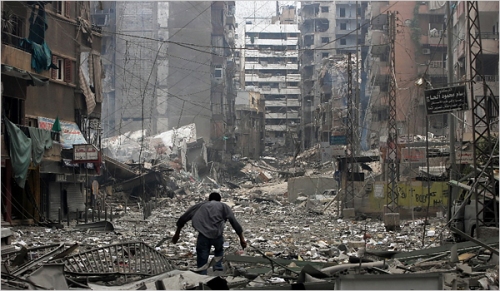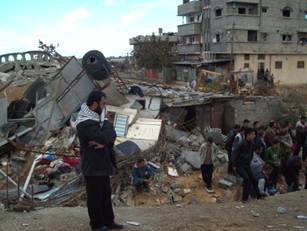Far from breaking, or even straining, the U.S. military is ready to surge into Afghanistan at any time. At least that is what military officials implied last week when they announced their "historic" recruitment figures for the year.
"It’s something that the framers never [anticipated]," enthused Bill Carr, deputy undersecretary of defense for military personnel policy, talking about the increased aptitude and education levels of the 2009 recruits. He boasted this at an Oct. 1 Pentagon briefing designed to highlight how the Army beat its fiscal year recruiting goals by 3 percent. "[It's] really an American achievement."
While the framers may have had other things to say – this being the eighth year of two simultaneous foreign interventions in which the nation’s leaders still cannot clearly articulate why we are there and what a so-called victory or exit should look like – that is another story. This is a story about how the military sells escalation, and to do so effectively, it must convince the public that its volunteer forces are healthy, hearty, willing, and able to surge another day.
For one, it lowers its recruitment goals year after year, and then when it achieves or exceeds those goals, it enjoins mainstream news reporters in the Pentagon briefing room to write the story straight. That’s how you get headlines like this one from the Washington Post: "A Historic Success in Military Recruiting; In Midst of Downturn, All Targets Are Met."
Then it throws the words "historic" and "record high" around so much that reporters like Eli Lake at the right-wing Washington Times apparently get confused. He led his report with "the U.S. military Tuesday reported the biggest surge in recruits since the end of the draft – an increase that likely will relieve pressure on troops serving in Iraq and Afghanistan by allowing them to spend more time at home between overseas deployments."
The Pentagon press office couldn’t have written it better, but now I am confused. According to Lake, the Pentagon told him the 169,000 recruits for FY 2009 is the "highest figure since 1973, the first year of the modern all-volunteer force." But a quick look at the FY 2008 figures shows the U.S. Armed Forces recruited 184,841 last year. And the goals were set higher. For example, last year the Army’s recruitment goal was set at 80,000; it exceeded that with 80,517. The Army’s 2009 goal was 65,000; it exceeded that goal by recruiting 70,045. This can hardly be recognized as a 36-year record, can it?
Slate.com’s Fred Kaplan noticed the fancy footwork at the press briefing, too, and called military officials to explain why the Army seemed to be "shrinking" while everyone else was reporting that it was exploding at epic levels. They told him they lowered goals year to year because of higher retention rates: it was just unnecessary to set the goals so high this year because so many soldiers were re-enlisting. In fact, they set FY 2009 reenlistment goals at 55,000 and got 68,000, another blowout year.
Don’t pop the corks yet. As Kaplan points out, in the years previous they had not only exceeded greater expectations for retention, but exceeded this year’s 2009 figures, too. For example, in FY 2008, the goal was 65,000 reenlistments. They got 72,000, in effect, 4,000 more than this year.
Kaplan actually suggests there might be more than a shell game at hand:
"Back in the 1980s, when I was a defense reporter for the Boston Globe, Ronald Reagan’s defense secretary, Caspar Weinberger, actually did this. The military fell short of the recruitment goal one year, so Weinberger (or perhaps an assistant secretary) simply lowered the goal and declared success. (A former official in the Army’s recruitment command, who still works in the Defense Department, confirmed my memory of this incident.)
"I’m not saying that someone in the Army today is pulling this same stunt. But something odd is going on, and the powers that be in the Pentagon and Congress might want to start asking questions."
Not that this should come as any surprise. The military is obviously pulling out all the stops to prod, cajole, and intimidate the remaining administration skeptics into surging in Afghanistan. However, the idea that the Armed Forces could go from a "death spiral" in 2007 to an "American dream," a veritable gold rush of brains, brawn, and spirit two years later, should give anyone pause.
True or not, this is the Pentagon’s story and they are sticking with it. Which is unfortunate. In order to fairly debate continuing the two-front occupation on its merits, we need to know the real fitness of our Armed Forces. Propping it up à la Weekend at Bernie’s is doing no one any good – not the American people sacrificing for the war, nor the military ranks, which are expected to carry on with existing resources as though the last eight years never happened.
Uncle Sam: The Employment Fairy?
While military officials play fast and loose with the recruitment outlook, they also understate the effect the depressed economy has on their ability to steer young men and women into to local recruitment offices, and the jacked-up signing bonuses – $14,000 per recruit, on average – they use to keep them there.
Instead, the Pentagon says a heightened sense of commitment and super recruitment efforts fanning about the country – more than 8,000 recruiters in the field – are pulling in the numbers. Gathering from stories over the last year or so, these recruiters indeed worked pretty hard. In fact, in some places, their jobs may be killing them.
But what military leaders seemed reticent to acknowledge during the Oct. 1 briefing is that the recession is indeed a primary reason for the exceeded, albeit reduced, annual recruiting goals. What kind of patriotism is it when a young high school graduate with no discernible options is willing to risk life and limb for a paying job, and if he’s lucky enough to get out with his brains intact, a college education? Is it just plain self-preservation? Desperation even?
One look at state unemployment figures, and one wonders. The military says the majority of its recruits still come from the South. Historical and cultural attachments aside, several Southern states exceed the national unemployment average, which is now at around 9.8 percent, and their sons and daughters are clearly seeing the military as a way out. For example, by the most recent assessments, Florida’s jobless rate is at 10.9 percent, Georgia’s is at 10.1 percent, South Carolina’s is at 11.5 percent, and Alabama’s is at has 10.4 percent.
But high unemployment is by no means exclusive to the South. Michigan still leads all other states with 15.3 percent unemployment, while Nevada has 13.2 percent, California 12.2 percent, Rhode Island 12.8 percent, and New York 10.3 percent.
Perversely, the climate couldn’t be better for the all-volunteer military. Unfortunately, says blogger Michael Roston, "I’d rather salute Americans by finding them jobs that don’t involve armored vehicles and improvised explosive devices."
And how about citizenship? Don’t forget the more than 22,000 enlisted holding green cards. They’ve been promised the fast track to naturalization if they take up the gun. One of the dirtiest secrets of our time is that we rail and writhe over the encroaching surge of immigrant DNA into the American gene pool, but we gladly welcome that blood to spill in our never ending conflicts overseas.
So You Want to Join the Military?
Paul Sullivan, director of Veterans for Common Sense, has been fighting for years to bring attention to the real toll of war on the men and women of the Armed Forces. His organization has launched a federal lawsuit against the government for allegedly denying and delaying care to wounded vets, and it gives no quarter in the struggle to shed light onto the meat grinder of the war machine. He did not take well to the upbeat tone of the recent Pentagon briefing.
"The Pentagon report is all ’smoke and mirrors,’" he said in an e-mail, noting that the military was spending upward of $1.7 billion on advertising and recruitment each year. "This is a multi-billion sales campaign, not a recruiting effort."
"Overall, the Washington Post failed to do any real investigative journalism," into how the military came up with its recruitment figures, Sullivan said.
It certainly wouldn’t have taken much investigation for the Washington Post or any of the other mainstream news outlets to balance out what was an obvious Pentagon PR blitz with stuff we already know. And what we already know – but may not be willing to examine too closely – is that without high unemployment and record signing bonuses, recruitment is a tough slog. And the reasons are obvious.
There are the soldier suicides and sexual assaults, the low morale, and the lifelong injuries and combat illnesses – like those incurred by those who have lived near the base burn pits overseas or have eaten spoiled food or showered in dirty water supplied by defense contractors. We all know about the backlogs at the VA and the fact that soldiers who were promised money to cover college tuition this year still haven’t received it.
We know that once in, soldiers will be expected to rotate in and out of the war zone on a 1:1 dwell time ratio – that’s one year in, one year out. And the Army doesn’t seem to care what shape you’re in when you redeploy, at least according to these harrowing accounts. Meanwhile, domestic strife is high among military families, especially for female soldiers, who represent 11 percent of deployed servicemembers and have triple the divorce rate of their male counterparts.
According to recent studies, 44 percent of the more than 400,000 Iraq and Afghanistan vets who have gone to the Veterans Administration for medical care since the beginning of the war were diagnosed with post-traumatic stress disorder or another mental health need. Those vets are also at greater risk of heart disease, another study finds. And, an estimated 320,000 returning soldiers are said to have some degree of brain injury due to blasts and accidents on the battlefield.
As for the fighting itself, the Washington Post has been vigilant lately about producing stories that suggest how weak links in the chain of command have put soldiers in harm’s way in Afghanistan. Recent reports in other news outlets point to sinking morale among the troops there.
However, when less than one half of 1 percent of the population is actually serving in the Armed Forces, it is difficult for the rest of us to comprehend the hardships of the professional military. But think about it: we may be avoiding the dreaded draft by straining these volunteers to the limit, but at what cost? Without our attention and outrage, the surges will continue, through this generation and likely into the next, if some of today’s warhawks and counterinsurgents have their way.
So while it is obvious why the Pentagon would like to steer our focus in another direction, that does not let the media off the hook, since it should have known it was being fed a line.
Read more by Kelley B. Vlahos








